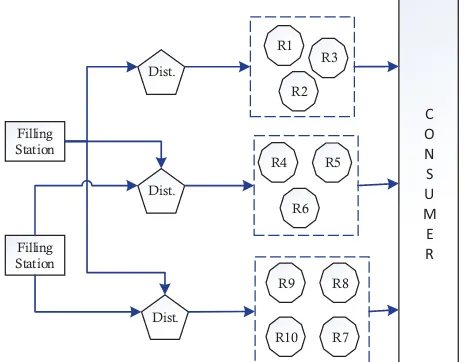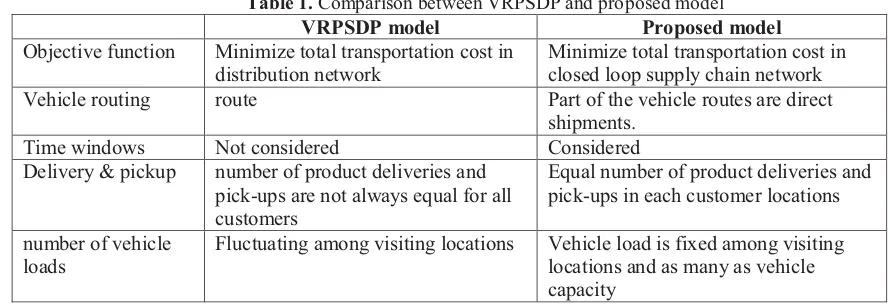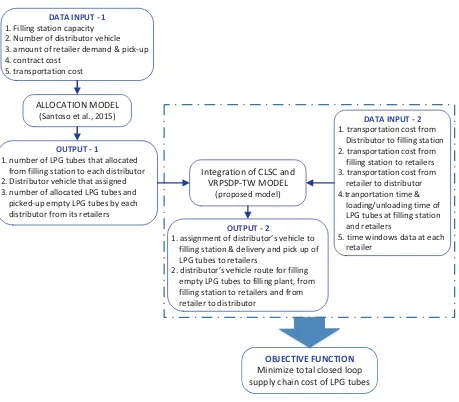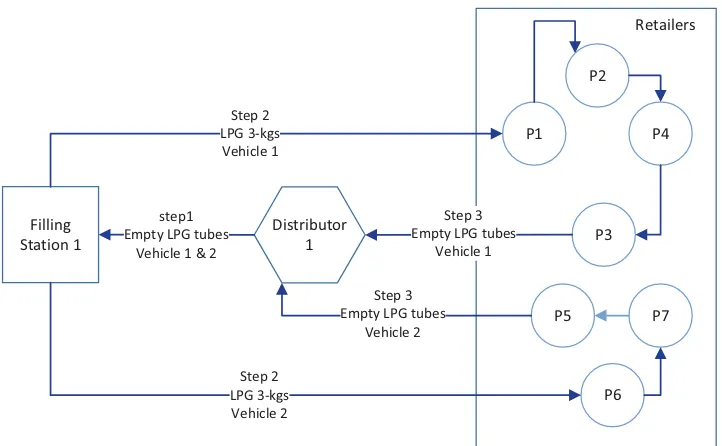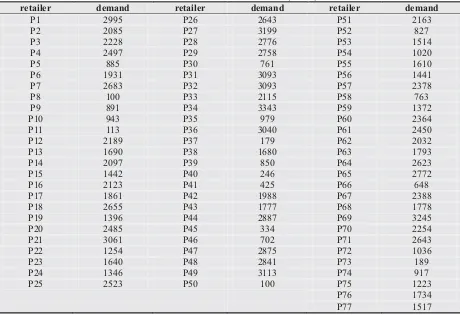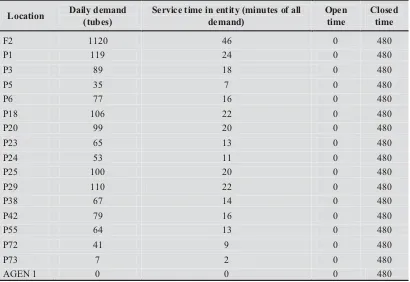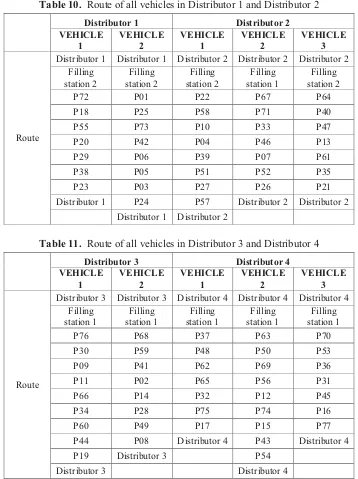ii
CONTENTS
PAGE
Welcome Speech from Dean, Faculty of Engineering, Mahidol University x
Conference Committee xii
Conference Sponsor xv
Keynote Speaker xvi
Program Overview xvii
Session 1 – Rail Transportation
Using Innovative Solutions in Rail Network Planning and Evaluation
Nate Chanchareon 1
The Establishment and Location Analysis of Dry Port: A Case of Southern Thailand
Kraisee Komchornrit and Waressara Weerawat 2
Statistical Analyses of Motivations to Participate in A Rail Focused Extra-Curricular Activity and Its Short Terms Personal Impacts
Anna Fraszczyk, Dmytro Drobisher and Marin Marinov 14
Session 2 – Current Supply Chain Focus
Impact of Climate Change on Supply Chain Network: A Systematic Literature Review
Hendrik Wurtmann and Abhijeet Ghadge 32
Development of a Disaster Relief Logistics Model Minimizing the Range of Delivery Time
Kei Kokaji and Yasutaka Kainuma 40
Cars Evacuation Plan in the Event of Flooding: A Case Study of Urban Hat YaiSongkhla Province
Jirasuk Panitchkul, Sakesun Suthummanon, Wanatchapong Kongkaew
and Sirirat Suwatcharachaitiwong 49
Demand and Supply Integration: A Case Study of Marché International De Rungis – France
Juan Marcelo Gomez, Jennyfer Kuanji, Ahmed Kaouachi and Andreas Ioannides 57
A Distance and Population-Based Location for Thailand’s Logistics Hub
iii
Impacts of ASEAN Open Skies Policy On Air Cargo Industry in Thailand
Araya Sakburanapech 78
Understanding Tourist Movement Pattern: Value Chain Approach
Putu Giri Artha Kusuma, Senator Nur Bahagia, Lucia Diawati and Myra P. Gunawan 86
Lean Six Sigma Guideline for Made-to-Order Production Industry
Yutthaphon Khayankit and Jirapan Liangrokapart 98
The Impact of Culture on Mobile Phone Purchasing: A Comparison between Thai and British Consumers
Monthathip Srikes 110
Session 4 – Industry
Business Process Management Practice for Micro Enterprise in Indonesia
Mahendrawathi Er, Nyoman Pujawan and Umi Chotijah 115
Preventive Maintenance Strategies: Literature Review and Directions
Ade Supriatna, Moses L. Singgih, Nani Kurniati and Erwin Widodo 127
A Conceptual Model for Supplier Integration and Development in the Thai Automotive Industry
Porpan Vachajitpan and Nichakorn Thongplew 140
Building in Quality Through Equipment Maintenance: A New Approach for Managing Production System
Nani Kurniati and Yulia Hening 152
Reshaping Business Models for Digital Era in Manufacturing Industries Supply Chains
Jukka Hemilä 160
The Estimation of the Cost of Service and Repair of Spare Parts to Support the Warranty Period
Valeriana Lukitosari, Suparno, I Nyoman Pujawan, and Basuki Widodo 169
Facility Location Model for Oil and Gas Industry: A Case Study of an Oil and Gas Company in Indonesia
Dody Hartanto and Muhammad Fazlurrahman Arief 178
Defect Reduction from Copper in Hole in Printed Circuit Board
Wanwisa Duantrakoonsil and Assadej Vanichchinchai 188
The Role of Change Agent in Lean Manufacturing Implementation
iv Session 5 – Supply Chain Risk and Uncertainty
Risk Mitigation Strategy for Dairy Products in Indonesia
Dewanti Anggrahini and Putu Dana Karningsih 205
A Social Network Analysis (SNA) Approach to Manage Supply Chain Information Risks
Leon Kok Yang Teo, Duy Dang-Pham, and Mathews Nkhoma. 213
Return and Risk Equivalence among Different Supply Chain Contracts
Shirsendu Nandi 225
Risk Management for Local Logistics Service Provider Focusing on Outbound Road Freight Transportation
Thutchanan Sangwan and Jirapan Liangrokapart 236
Two Risk Assessment and Evaluation Approaches for Critical Logistical Infrastructures
Sascha Düerkop and Michael Huth 248
Supply Chain Risk Management and Stakeholder Analysis in Supply Chain: A Conceptual Model
Syarifuddin Mabe Parenreng , Nyoman Pujawan and Putu Dana Karningsih 256
Risks and Trust Identification for SMEs Assessment
Tawinan Simajaruk and Jirapan Liangrokapart 260
Impact of Pricing Policies on Profit and Revenue of Consumer Product Supply Chain with Uncertain Costs
Chatdanai Kaorapapong and Pisal Yenradee 274
Session 6 – Port and Maritime Logistics
A Simulation Study for Maritime Inventory Routing Problem with Supply and Transportation Disruptions
Nurhadi Siswanto 286
The Latest Seven Years of Maritime Policy: Literature Review and Opportunity for Future Research
Pratomo Setyohadi, Ketut Buda Artana, Djauhar Manfaatand,
and Raja OloanSaut Gurning 296
Prospects of Nearshoring European Manufacturing Located in China to Russia
Yulia Panova and Per Hilletofth 308
Berth Allocation Problem Under Uncertainty: Preliminary Study at Koja Container Terminal
v Session 7 – Transport Management
Vehicle Routing Problem for Optimizing Multi Temperature Joint Distribution On Distribution of Perishable Product
Luki Trihardani 331
Balancing Vehicle Utilization on Capacitated Vehicle Routing Problem with Time Windows8sing Simulated Annealing Algorithm
David T. Liputra, Victor Suhandi and Rifki Ramdani 344
Freight Forwarder's Capacity Booking: A Conceptual Model
Alain Widjanarka, BudisantosoWirjodirdjo, Nyoman Pujawan and Imam Baihaqi 352
Developing Model of Closed Loop Supply Chain Network for Subsidized LPG 3-kgs in East Java-Indonesia
Amelia Santoso, JoniartoParung and Dina N. Prayogo 365
The Practice of Business and IT Integration in the Transport Company Using Enterprise Architecture Framework
Valeriy Kurganov and Aleksey Dorofeev 377
Session 8 – Green Supply Chain
Using the Quantitative and Qualitative Methods for the Modelling of the Green Supply Chain
Blanka Tundys 392
Perception and Adaptation of Sugar Industry Toward Green Logistics in Eastern Area, Thailand
Oranicha Buthphorm 415
Carbon Pricing System for Vehicles Used in Freight Transport
Sattra Vuthy, Ronnachai Tiyarattanachai and Jaruwit Prabnasak 429
Toward Green Library Building Based on Energy Conservation
Putu Karningsih, Udisubakti Ciptomulyono, Arrifah Sari and Bima Sofhananda 441
Session 9 – Simulation Modelling
A Simulation Model for Facility Allocation of New Built Outpatient Department
Soriya Hoeur and Duangpun Kritchanchai 452
Duration of Collaboration from A Market Perspective: An Agent-Based Modeling Approach
Niniet I. Arvitrida, Antuela A. Tako, Duncan Robertson and Stewart Robinson 468
Research on Selecting Logistics Network Considered with Omni-Channel
vi
Drug Inventory Modelling for Internal Supply Chain in the Hospital
Prita Meilanitasari, IwanVanany and Erwin Widodo 490
A Literature Review on Different Models and Solution Approaches on Order Picking Problem
Shirsendu Nandi and Patanjal Kumar 502
Session 10 – Sustainability Logistics & Supply Chain
Sustainability Indicators for Third Party Logistics Providers
Yurawan Nitisaroj and Jirapan Liangrokapart 515
Pursuing Sustainability Via Reverse Logistics: The Symbiosis Effect Between the Local Authorities and Householders
Emy Ezura A Jalil 525
Integrating Life Cycle and Value Stream Mapping to Enhance Total Sustainability
Sri Hartini, Udisubakti Ciptomulyono and Maria Anityasari 539
Cost of Quality, ISO 9001 and its Impact on Corporate Performance: A Literature Review
Muhammad Rosiawan, Moses L. Singgih and Erwin Widodo 554
The Role of Stakeholder Engagement in External Assurance of Sustainability Reporting
Yahaya Yusuf, Emmanuel Olasanmoye, Louise Mc Ardle, Wendy Auchterlounie
and Masha Menhat 565
Designing a Sustainable and Resilient Supply Chain: An Empirical Case Study
Behnam Fahimnia and Armin Jabbarzadeh 566
Session 11 – Healthcare Supply Chain
An Exploratory Study of Healthcare Supply Chain
Duangpun Kritchanchai and Sineenart Krichanchai 567
Identification of Key Factors for Healthcare Group Purchasing Development: A Literature Review
Bundid Kungwannarongkun and Jirapan Liangrokapart 582
Factors Affecting IT Projects Success: Case of Healthcare Flows
Smaïl Benzidia, Omar Bentahar, Meriam Karaa and Blandine Ageron 596
Towards A Process Reference Model for Healthcare Supply Chain
Wirachchaya Chanpuypetch and Duangpun Kritchanchai 608
A Conceptual Framework of Internal Flexibility in Healthcare Service Operations: Role of Advanced Medical Technologies and Operations Improvement Practices
vii
Process Analysis for Blood Supply Chain Using Event Log
Iwan Vanany, Anny Maryani, Prita Meilanitasari, Erma Suryani and Bilqis Amaliah 628
Block Appointment Scheduling at a Specialty Clinic: A Case Study
Rajesh Piplani 636
Building sustainable service supply in primary care unit
Phallapa Petison 637
Session 12 – Apparel Supply Chains and Corporate Social Responsibility
Supply Chains and Products: A Marketing Production-Perspective
George Hadjinicola 638
Value Co-Creation in Services Flow for the Competitiveness of Supply Chain: Conceptual Framework
Umer Mukhtar, Sarwar M. Azhar and Tashfeen M. Azhar 645
The Future of Customer Value-Multi-Industry Insights of Value Determinants in Service Networks
JyriVilko, Nina Helander and Marko Seppänen 646
Implementation of Social Compliance of the Apparel Industry: A Challenging Road Ahead
Suraiyah Akbar and Kamrul Ahsan 657
Imbalancing Between Demand and Supply of Manpower for Textile Industry in Thailand
Walailak Atthirawong, Ronnachai Sirovetnukul, Kanogkan Leerojanaprapa,
Wariya Panprung and Tanawat Ruangteprat 680
Creating Market Responsiveness through Cross-Functional Integration
Ana Beatriz Murillo Oviedo, MarcioLopes Pimenta and Per Hilletofth 691
Session 13 – Food Supply and Distribution
Network Constraints of Reallocating Seafood Freight from Road to Sea Transport
Per Engelseth, Irina V. Karlsen, Shulin Huang and Arild Hoff 703
Food Security is None of Your Business? Food Supply Chain Management in Support of Sustainable Food System
Ari Paloviita 715
Design for Mass Customization in Food Industry: Literature Review and Research Agenda
viii
Contracts in Supply Chain of Fishery Product Considering Traceability and Regulatory Compliance
Winda Narulidea, Oki Anita Candra Dewi and Luki Trihardani 738
Model Development of Supply Chain Network for Fresh Agricultural Products in East Java by Considering the Levels of Product Quality
Joniarto Parung, Amelia Santoso and Dina N. Prayogo 752
Integrated Analysis of Short Food Supply Chain Solution In Order To Design a Suitable Logistics Solution
Alexis Nsamzinshuti and Alassane BalléNdiaye 764
Session 14 – Logistics Management
Supplier Selection Model Considering Truckload Shipping
Purnawan Adi Wicaksono, Bambang Purwanggono,I Nyoman Pujawan,
and Erwin Widodo 781
The Impact of Customer Orientation of Service Employees on Customer Satisfaction, Commitment and Retention in Logistics Service Providers
Imam Baihaqi and Berto Mulia Wibawa 792
Delivery Planning of Last Mile Logistics Considering Absence Probability on Each Term
Yuki Shigeta, Kazuho Yoshimoto and Shunichi Ohmori 799
The Estimating Transportation Time for Item Picking in Warehouse Considered with Item Characteristics and External Factors
Taisuke Kasuga, Kazuho Yoshimoto and Shunichi Ohmori 811
The Mix-Method Pallet Loading Problem With a Variety of Box Sizes Under Weight and Height Limitation: A Case Study of Indoor and Outdoor Lighting Products
Phatcharee Toghaw Thongrattana and Kajornnat Deonphen 822
Vehicle Routing Problem with Pickup and Delivery by Considering Time
Window, Last-In First-Out, /RDGLQJDnd Maximum Route Duration Constraints
Suprayogi and Andriansyah Andriansyah 830
A Time-Dependent Vehicle Routing Algorithms for Medical Supplies Distribution Under Emergency
Tsai-Yun Liao, Ta-Yin Hu and Yu-Wen Wu 840
Session 15 – Information Technology and Supply Chain Management
Industry 4.0: What Does It Mean to Supply Chain Management?
ix
Enterprise Resource Planning System Implementation: An End-User Perspective
Ewout Reitsma, David Wewering and Per Hilletofth 865
Can Improved Transparency Reduce Supply Chain Risks in Cloud Computing?
Olusola Akinrolabu and Steve New 877
A review of the Efficiencies of Big Data Analytics in Supply Chain
Janya Chanchaichujit, Albert Tan, Wuigee Tan
and Sandhya Cheramparampil Surendran 893
ICT Use in Higher Education: Satisfaction with MOODLE as A Learning Management System
Aleksander Aristovnik, Nina Tomazevic, Lan Umek and Damjana Kerzic 902
Computerized Maintenance Management System: Literature Review
Donladit Mueangman 913
Influence of Cognitive Aspect and Affective Aspects on The Usability Performance of E-Commerce
Heru Prastawa, Udisubakti Ciptomulyono, Moses Laksono Singgih
and Markus Hartono 923
Session16 – Optimization and Operation Research
Optimization of Cambering Process by Determination of Process Parameter to Improve of Parabolic Leaf Spring
Evelyn DwiLavinia, Ig. Jaka Mulyana, and Ivan Gunawan 935
Optimizing Mean and Variance Simultaneously in Multiple Response Optimization Problems
Sasadhar Bera and Indrajit Mukherjee 946
Application of Optimization Modeling to Derive an Engineering Characteristic in QFD
Dian Retno Sari Dewi and Elisa Yuanita 955
Decision on Optimal Display Space Following Demand Fluctuation
Kazuki Ishichi, Kazuho Yoshimoto and Shunichi Ohmori 962
The Adopting of Markov Analysis to Forecast the Operations Competitive Advantages of Mobile Phone Service Providers: The Case of Jordan
Yazan Khalid Abed-Allah Migdadi 973
Capacity Reservation and Utilization for A Manufacturer with Uncertain Capacity and Demand
x
Critical Operations Capabilities in A High Cost Environment: A Focus Group Study
xviii
OSCM 2016– PROGRAMOVERVIEW December18th,2016(Sun)
14:00–17:00 Registration
CentaraGrandBeachResortPhuket
December19th,2016(Mon)
08:00–09:00 Registration
CentaraGrandBeachResortPhuket
09:00–10:00
RoomA OpeningCeremony
x ReportbyAssoc.Prof.Dr.DuangpunKritchanchai,OSCMGeneralCoChair,MahidolUniversity,Thailandand Prof.NyomanPujawan,OSCMGeneralCoChair,InstitutTeknologiSepuluhNopember(ITS),Indonesia
x WelcomeaddressbyAssist.Prof.Dr.YodchananWongsawat,ViceDeanforGraduateStudiesandInternationalRelationsoftheFacultyofEngineering,MahidolUniversity x OpeningaddressbyMr.TeeraAnantaseriwidhya,ViceGovernorofPhuketProvince
GroupPhoto
10:00–10:50
KeynoteI
“Newdirectionsofresearchfortransformationalchangeinsupplychaindesignandpractices”
ProfessorLatitJohri,SeniorFellowinInternationalBusinessandtheDirectoroftheOxfordAdvancedManagementandLeadershipProgrammeatSaïdBusinessSchool,UniversityofOxford,UnitedKingdom
10:50–11:10 CoffeeBreak
11:10–12:00
KeynoteII
“DevelopmentsandDirectionsinSustainableSupplyChainManagement”
ProfessorStefanSeuring,ProfessorofSupplyChainManagement,UniversityofKassel,Germany
12:00–13:00 Lunch SessionChair:AssadejVanichchinchai
xix SessionChair:AssadejVanichchinchai
Session4– Industry (Cont.) SessionChair:JukkaHemilä
Session5 – SupplyChainRiskandUncertainty(Cont.) SessionChair:PutuDanaKarningsih
Paper25:Impactof PricingPoliciesonProfitand RevenueofConsumerProductSupplyChainwith UncertainCosts
ChatdanaiKaorapapongandPisalYenradee Paper75: TheImpactofCultureonMobilePhone
Purchasing:AComparisonbetweenThaiand
Session6 – PortandMaritimeLogistics SessionChair:NurhadiSiswanto
xx
OSCM 2016– PROGRAMOVERVIEW
Paper78:ThePracticeofBusinessandIT IntegrationintheTransportCompanyUsing EnterpriseArchitectureFramework ValeriyKurganovandAlekseyDorofeev December20th,2016(Tue)
08:00–09:00 Registration
CentaraGrandBeachResortPhuket
09:00–10:30
RoomA RoomB RoomC
TaniaSnioch
Session9 – SimulationModelling SessionChair:ShunichiOhmori
Session10 – SustainabilityLogistics&SupplyChain SessionChair:EmyEzuraAJalil
Paper19: DesigningaSustainableandResilientSupply Chain:AnEmpiricalCasestudy
Session11 – HealthcareSupplyChain SessionChair:Dr.DuangpunKritchanchai, DirectorofHealthcareSupplyChainExcellence
Centre,MahidolUniversity,Thailand
xxi
Paper88:TheImpactofCustomerOrientationof ServiceEmployeesonCustomerSatisfaction, CommitmentandRetentioninLogisticsService Providers
ImamBaihaqiandBertoMuliaWibawa
Paper180:DeliveryPlanningofLastMileLogistics ConsideringAbsenceProbabilityonEachTerm YukiShigeta,KazuhoYoshimotoandShunichiOhmori
Paper119:TheEstimatingTransportationTimefor ItemPickinginWarehouseConsideredwithItem CharacteristicsandExternalFactors
TaisukeKasuga,KazuhoYoshimotoand ShunichiOhmori
Paper98:TheMixMethodPalletLoadingProblem WithaVarietyofBoxSizesUnderWeightandHeight Limitation:ACaseStudyofIndoorandOutdoor LightingProducts
PhatchareeToghawThongrattanaand KajornnatDeonphen
Paper67:VehicleRoutingProblemwithPickupand DeliverybyConsideringTimeWindow,LastInFirst Out, ndMaximumRouteDuration ConstraintsSuprayogiandAndriansyahAndriansyah Paper80:ATimeDependentVehicleRouting AlgorithmsforMedicalSuppliesDistributionUnder
Session15 – InformationTechnologyinSupply ChainManagement
SessionChair:Dr.BennyTjahjono, CranfieldUniversity,UK
xxii
OSCM 2016– PROGRAMOVERVIEW Paper170:AreviewoftheEfficienciesofBigData
AnalyticsinSupplyChain
JanyaChanchaichujit,AlbertTan,WuigeeTanand SandhyaCheramparampilSurendran
Paper121:Decisionon OptimalDisplaySpace FollowingDemandFluctuation
KazukiIshichi,KazuhoYoshimotoand ShunichiOhmori
Paper130:ICTUseinHigherEducation: SatisfactionwithMOODLEasALearning ManagementSystem
AleksanderAristovnik,NinaTomazevic,LanUmek andDamjanaKerzic
Paper86:TheAdoptingofMarkovAnalysisto ForecasttheOperationsCompetitive
AdvantagesofMobilePhoneServiceProviders: TheCaseofJordan
YazanKhalidAbedAllahMigdadi Paper148:ComputerizedMaintenance
ManagementSystem:LiteratureReview DonladitMueangman
Paper156:CapacityReservationandUtilization forAManufacturerwithUncertainCapacityand Demand
YoussefBoulaksil
Paper50:InfluenceofCognitiveAspectand AffectiveAspectsonTheUsabilityPerformanceof ECommerce
HeruPrastawa,UdisubaktiCiptomulyono, MosesLaksonoSinggihandMarkusHartono
Paper91:CriticalOperationsCapabilitiesinA HighCostEnvironment:AFocusGroupStudy CinziaSansone,PerHilletofthandDavidEriksson
15:30–15:45 CoffeeBreak
15:45–17:30
SCHOLARDEVELOPMENTPROGRAM PartI:CriticalAspectsofSuccessfulAcademics
PartII:ResearchandPublishing 17:45–20:30
GalaDinner&Awards
x18:30–18:45ClosingRemarksbyAssist.Prof.Dr.YodchananWongsawat,ViceDeanforGraduateStudiesandInternationalRelationsoftheFacultyofEngineering,MahidolUniversity x18:45–19:00BestPaperAwardsAnnouncementbyProf.Dr.NyomanPujawan,OSCMGeneralCoChair,InstitutTeknologiSepuluhNopember(ITS),Indonesia
DEVELOPING MODEL OF CLOSED LOOP SUPPLY CHAIN
NETWORK FOR SUBSIDIZED LPG 3-KGS IN EAST
JAVA-INDONESIA
Amelia Santoso
Department of Industrial Engineering, University of Surabaya, Surabaya 60293 Indonesia, E-mail: [email protected]
Joniarto Parung
Department of Industrial Engineering, University of Surabaya, Surabaya 60293 Indonesia, E-mail: [email protected]
Dina N. Prayogo
Department of Industrial Engineering, University of Surabaya, Surabaya 60293 Indonesia, E-mail: [email protected]
ABSTRACT
Demand of subsidized LPG 3-kgs in Indonesia has been increasing since the Indonesian government imposed a conversion program from kerosene to Liquefied Petroleum Gas (LPG) in 2007. The high increase in demand for subsidized LPG 3-kgs led to the scarcity of products availability. The design of a closed distribution system is required to ensure the availability of subsidized LPG 3-kgs. In this research, the development model of the integration of closed loop supply chain network and vehicle routing problem with simultaneous deliveries and pick-ups with time windows has been proposed. The mechanism of closed distribution system starts from the distributors send LPG empty tubes to filling stations. After filling station inspected and filled the LPG tubes, distributors delivered LPG 3-kgs subsidized from the filling station to some retailers. At the same time, the distributors take back the empty tubes from these retailers by considering the limitations of operational time in each retailers. The proposed model was tested on numerical example and analyzed the results.
Keywords: Liquefied Petroleum Gas, Closed Loop Supply Chain Network Design
(CLSCND), Vehicle Routing Problem Simultaneous Deliveries and Pick-up with Time Windows (VRPSDPTW)
1. INTRODUCTION
Since 2007, the Indonesian government has made policy of the fuel conversion from kerosene to Liquefied Petroleum Gas (LPG) and provide subsidies for the weak economy society. Gas fuel conversion program has sparked a significant increase in demand of subsidized LPG 3-kgs. This was compounded by the existence of irregularities distribution of subsidized LPG 3-kg ineffective. This led to a scarcity of subsidized LPG 3-kgs availability, so the government adopted a policy through a closed system distribution program in each region. It requires appropriate setting of closed distribution systems for subsidized LPG 3-kgs in order to ensure the products availability according to community needs.
Development allocation optimization model of subsidized LPG 3-kgs in closed loop supply chain in each region had been done by Santoso et al. (2015) involving entities filling stations, distributors and retailers as shown in Figure 1 .The closed distribution system 3-kgs of subsidized LPG based on the allocation of supply of filling stations to distributors in accordance quotas listed in contacts which is expressed in the number of Loading Orders (LOs) for each time period. Furthermore, distributors do a closed distribution to multiple retailers within a certain area. At the time of sending LPG distributor 3-kgs subsidized to some specific retailers once conducted an empty LPG tubes from the retailers to be brought back and refilled in the filling stations. This mechanism in closed distribution system of subsidized LPG 3-kgs requires the optimal solution of the integration of closed loop supply chain network design (CLSC) and vehicle routing problem with simultaneous deliveries and pickups (VRPSDP).
Filling Station
Filling Station
Dist.
Dist.
Dist.
R4 R5
R6
R9
R7 R10
R8 R1
R2 R3
C O N S U M E R
Figure 1. Closed distribution structure of subsidized LPG 3-kg (Santoso et.al., 2015)
In addition, Section 2 will be discussed literature review related to the model of closed loop supply chain network design and vehicle routing problem with simultaneous deliveries and pick-ups. The research methodology is explained in Section 3. Section 4 describes in detail the development of the proposed integration model and applied to a numerical example in section 5. In the final section, we present some conclusions and further research.
2. LITERATURE REVIEW
The combination of forward and reverse supply chain will construct closed loop supply chain (Govindan et al., 2015). According to Govindan et al. (2015), closed-loop supply chain management is the design, control, and operation of a system with dynamic recovery of value from different types and volumes of return products to maximize value creation over the entire life cycle of a product. In order to reducing environmental impact, many companies share their returnable transport items (RTIs) among the different partners of a closed-loop supply chain (Iassinovskaia et al., 2016). RTIs means packaging material involved in secondary and tertiary packaging such as bottle, tubes, tray, etc.
In order to minimize the distribution costs of products, the company needs to design the right vehicle routing that suitable to their distribution systems requirement. In a closed-loop supply chain systems, vehicle routing is not only required in delivering products to consumers, but it is also necessary return products, re-usable packaging and goods to be recycled or
remanufactured have to be transported at the same time have to be transported (Dethloff, 2001). One type of vehicle routing problem (VRP) variants that suitable applied into closed loop supply
chain network is vehicle routing problem with simultaneous deliveries and pickups – VRPSDP
(Iassinovskaia et al., 2016).
Vehicle routing used in closed distribution network of the subsidized LPG 3-kgs is developed to determine the vehicle routes from a distributor to filling station and continues to deliver subsidized LPG 3-kgs to retailers and take the empty tubes from retailer locations back to the distributor. This distribution model is developed in order to minimize the total distribution costs. Retailers should return the empty tubes in according to the number of LPG tubes are delivered by their distributor. Therefore, the proposed model of the LPG 3-kgs distribution was developed based on Vehicle Routing Problem with Simultaneous Deliveries and Pick-Up (VRPSDP) model. VRPSDP model is variant of VRP model in which products need to be picked up from a certain location and dropped off at their destination (Braekers et al., 2015). Tasan and Gen, (2012) have proposed a genetic algorithm based approach as solution method for VRPSDP model (Tasan and Gen, 2012). There are several different characteristics between our proposed model and VRPSDP model that can be presented in Table 1.
Table 1. Comparison between VRPSDP and proposed model
VRPSDP model Proposed model
Objective function Minimize total transportation cost in
distribution network
Minimize total transportation cost in closed loop supply chain network
Vehicle routing route Part of the vehicle routes are direct
shipments.
Time windows Not considered Considered
Delivery & pickup number of product deliveries and
pick-ups are not always equal for all customers
Equal number of product deliveries and pick-ups in each customer locations
number of vehicle loads
Fluctuating among visiting locations Vehicle load is fixed among visiting
locations and as many as vehicle capacity
3. RESEARCH METHODOLOGY
This study is a continuation of the research conducted by Santoso et al. (2015), which related to the development of an optimization model for the allocation of a closed distribution system of subsidized LPG 3-kgs. The results of the optimal solution based on the optimization model become the input parameters for the model proposed. The linkage between the models that have been developed by (Santoso, 2015) and designing process of the proposed model can be described in Figure 2.
The research phase of the proposed model development can be described as follows. First, conducting literature review related to the development of integration model of closed loop supply chain networks (CLSCND) and vehicle routing problem with simultaneous deliveries and pickups with time windows (VRPSDP-TW). Based on the literature overview, we developed an integration model of CLSCND and VRPSDP by taking into account the limitations of operational time in each retailers (VRPSDP-TW). The proposed models will be validated using numerical example and solved by the exact method. Furthermore, we draw some conclusions based on the results of the proposed integration model.
DATA INPUT - 1
1. Filling station capacity 2. Number of distributor vehicle 3. amount of retailer demand & pick-up 4. contract cost
5. transportation cost
ALLOCATION MODEL (Santoso et al., 2015)
OUTPUT - 1
1. number of LPG tubes that allocated from filling station to each distributor 2. Distributor vehicle that assigned 3. number of allocated LPG tubes and
picked-up empty LPG tubes by each distributor from its retailers
Integration of CLSC and VRPSDP-TW MODEL
(proposed model)
DATA INPUT - 2
1. transportation cost from Distributor to filling station 2. transportation cost from
filling station to retailers 3. transportation cost from
retailer to distributor 4.tranportation time &
loading/unloading time of LPG tubes at filling station and retailers
5. time windows data at each retailer
OUTPUT - 2
1. assignment of distributor’s vehicle to
filling station & delivery and pick up of LPG tubes to retailers
2. distributor’s vehicle route for filling
empty LPG tubes to filling plant, from filling station to retailers and from retailer to distributor
OBJECTIVE FUNCTION
Minimize total closed loop supply chain cost of LPG tubes
Figure 2. Research steps
4. MODEL DEVELOPMENT
The closed loop supply chain structure of LPG 3-kgs consists of multi filling station, multi distributor and multi retailer (Chopra and Meindl, 2016). A filling station supplies multi certain distributor and a distributor can be supplied by more than one certain filling station. A distributor supplies multi certain retailer but a retailer can be supplied by only a certain distributor which is authorized to distribute subsidized LPG on the retailer. Vehicle is only had by distributors and a distributor can have more than one vehicle.
Mechanism of distributing LPG 3-kgs is describe as shown in Figure 3. A distributor’s
vehicle brings a truck of empty LPG tubes (560 tubes) to certain filling station that are authorized to fulfill LPG to empty 3-kgs tubes according to quota. From filling station, the vehicle directly to
distribute the LPG 3-kgs tubes to retailers ordered to distributor. When the distributor’s vehicle
delivers the LPG 3-kgs tubes to a certain retailer, the vehicle also collects the empty LPG 3-kgs tubes as number of delivered LPG 3-kgs tubes and brings it return to distributor. After delivering LPG 3-kgs tubes to the last retailer of that route, the vehicle return to the distributor.
Retailers
Filling Station 1
Distributor 1
P1 P2
P3 P4
P5 P7
P6
step1 Empty LPG tubes
Vehicle 1 & 2 Step 2 LPG 3-kgs Vehicle 1
Step 3 Empty LPG tubes
Vehicle 1
Step 2 LPG 3-kgs Vehicle 2
Step 3 Empty LPG tubes
Vehicle 2
Figure 3. Closed distribution flow of subsidized LPG 3-kgs
The proposed model of integrated closed loop supply chain (CLSC) and vehicle routing problem with simultaneous deliveries and pickups with time windows (VRPSDPTW) is developed for distributing subsidized LPG 3-kgs from filling stations to distributors and from distributors to retailers. The objective of this model is to minimize total closed loop supply chain cost of LPG
tubes. This proposed model determines the assignment of distributor’s vehicle to filling station,
and delivery and pick up of LPG tubes to retailers. This model also determine route of
distributor’s vehicle for filling empty LPG tubes to filling plant, from filling station to retailers
and from retailer to distributor.
4.1 Mathematical Notations
The mathematic notations included sets, variables, parameters, and decision variables that are used in this developing model as follows:
Set
S : set of filling station nodes
A : set of distributor nodes
P : set of retailer nodes
N : set of all nodes including filling station, distributor and retailer; N= S AP
V : set of vehicles
Variables/Parameters
FCs : Fixed (contract) cost between filling station sand distributor
: Transportation cost from distributor ato filling station s
Cijj : Transportation cost from node ito node j;i, j= N SA P : LPG demand at retailer j
Pj : Number of empty LPG tubes to be taken from retailer j
JTa : Number of vehicles that owned by distributor a
: Number of vehicles that assigned by distributor ato filling station s
Si : Service time at node i;iSP
Tij : Travel time from node ito node j;i, jSA P
Decision Variables
Qijv : Number of LPG tubes that delivered from node ito node jby using vehicle v
Zijv : Binary decision variable that indicates whether LPG tubes are delivered from node i to
node jby using vehicle v
Lsv : number of loads in vehicle vwhen it departs from filling station s
Li : number of vehicle loads when it departs from node i
: Number of empty LPG tubes that are delivered by distributor a using vehicle v to filling station s
: Binary decision variable that indicates whether empty LPG tubes are delivered by distributor ausing vehicle vto filling station s
Aj : Arrival time at node j
Bi : Departure time from node i
JTs : Number of vehicles that assigned to filling station s
4.2 Mathematical Formulation
The objective of closed loop supply chain model for subsidized LPG 3-kgs is minimizing the total closed loop supply chain cost of LPG. The total closed loop supply chain cost (TC) consists of total fixed cost at distributors, total transportation cost from distributor to filling station, total transportation cost among all nodes including transportation cost from filling station to the first retailer that is visited, transportation cost among retailers and from the last visited retailer to distributor. The total closed loop supply chain cost (TC) is formulated as follows:
(1)
Several constraints are considered to ensure the suitability of the developed model and the condition of distribution of subsidized LPG 3-kgs. Constraint (2) ensures number of LPG tubes are delivered from each distributor to filling station as the capacity of each vehicle, while constraint (3) guarantees load of each vehicle is less than vehicle capacity. Constraint (4) and (5) guarantee number of dispatched trucks by a distributor to each filling station corresponding to allocation of
each filling station’s supply capacity for that distributor and total number of truck that are assigned
by the distributor to each filling station.
(2)
(3)
(4)
(5)
Each truck sent from distributors are guaranteed by constraint (6) go to only one SPPBE and the number of trucks sent to all SPPBE guaranteed by constraint (7) as many as the number of trucks
owned by the distributor. Constraint (8) and (9) ensure that each truck owned by a distributor is sent from a filling station to only one of retailers and number of trucks that are sent from a filling station to all retailers as many as number of truck that are assigned by the distributor to the filling station.
(6)
(7)
(8)
(9)
Constraint (10) ensures each retailer is visited only by one truck from one of filling stations while constraints (11) guarantees the amount of load in the vehicle when it departs from the filling station equal to the total LPG tubes to be delivered to retailers. Constraint (12) guarantees number of vehicle loads when it departs from the first node j after filling station minimum as much as the number of loads in each vehicle when it departs from filling station reduced the number of LPG tubes that delivered and added the number of empty tubes taken from the first visited retailer.
(10)
(11)
(12)
Constraint (13) ensures number of vehicle loads when it departs from the first node j after filling
station minimum as much as the number of loads in vehicle when it departs from node i reduced
the number of LPG tubes that delivered and added the number of empty tubes taken from node j.
Constraint (14) and (15) Number of loads of vehicle is not exceed of vehicle capacity. Each vehicle loads only one LO (loading order), i.e.: 560 LPG tubes.
(13)
(14)
(15)
Constraint (16) ensures each distributor’s truck will visit one of retailers after visited a filling station while constraint (17) guarantees that a truck will go to another retailer or return to distributor after visiting a retailer. Each retailer is guaranteed by constraint (18) will be visited only by one truck that come from another retailer or from a filling station. Constraint (19) and (20) ensure each truck that arrived in a retailer will continue to visit another retailer or return to distributor.
(16)
(17)
(18)
(19)
(20)
Constraint (21) and (22) guarantee amount of LPG 3-kgs that are sent to a retailer corresponding
to the retailer’s demand. Constraint (23) deals with number of trucks return from retailer to a
distributor as many as number of trucks that are sent from the distributor to a filling station. Constraint (24) guarantees each truck that arrived at a filling station or a retailer has to continue its visiting immediately after is serviced.
(21)
(22)
(23)
(24)
Constraint (25), (26) and (27) ensure each truck start from a distributor at time=0, goes to a filling station then from the filling station, the truck goes to one of retailers. Constraint (28) ensures arrival at the distributor after the departure of the last retailer while constraint (29) ensures arrival time at a retailer after departing time from a filling station or another retailer. Constraint (30)
guarantees each vehicle will arrive at node j in range of its time window while constraint (31)
ensures the assigned vehicles must be moved to another node.
(25)
(26)
(27)
(28)
(29)
(30)
(31)
Constraint (32) deals with the binary decision variables and constraint (33) deals with the integer decision variables.
(32)
(33)
5. NUMERICAL EXAMPLE
Similar with Santoso et al. (2015), the supply chain structure of subsidized LPG 3-kgs consists of two filling stations, four distributors and 77 retailers. The capacity of filling stations and distributors can be seen in the Table 2 and demand of retailers are shown in the Table 3.
Table 2. The capacity of filling stations and distributors
filling station capacity distributor number of trucks capacity of truck
F1 84,000 D1 2 28,000
F2 67,200 D2 3 42,000
D3 2 28,000
D4 3 42,000
Table 3. Demand of each retailer (tubes)
retailer demand retailer demand retailer demand
P1 2995 P26 2643 P51 2163
P2 2085 P27 3199 P52 827
P3 2228 P28 2776 P53 1514
P4 2497 P29 2758 P54 1020
P5 885 P30 761 P55 1610
P6 1931 P31 3093 P56 1441
P7 2683 P32 3093 P57 2378
P8 100 P33 2115 P58 763
P9 891 P34 3343 P59 1372
P10 943 P35 979 P60 2364
P11 113 P36 3040 P61 2450
P12 2189 P37 179 P62 2032
P13 1690 P38 1680 P63 1793
P14 2097 P39 850 P64 2623
P15 1442 P40 246 P65 2772
P16 2123 P41 425 P66 648
P17 1861 P42 1988 P67 2388
P18 2655 P43 1777 P68 1778
P19 1396 P44 2887 P69 3245
P20 2485 P45 334 P70 2254
P21 3061 P46 702 P71 2643
P22 1254 P47 2875 P72 1036
P23 1640 P48 2841 P73 189
P24 1346 P49 3113 P74 917
P25 2523 P50 100 P75 1223
P76 1734 P77 1517
Table 4. and Table 5. show the fixed and variable cost of distribution from filling station to distributors.
Table 4. Fixed cost of distribution from filling station to distributor (rupiahs)
D1 D2 D3 D4
F1 144,000,000 142,000,000 129,000,000 143,000,000 F2 145,000,000 141,000,000 143,000,000 127,000,000
Table 5. Variable cost of distribution from filling station to distributor (rupiahs)
D1 D2 D3 D4
F1 78,000 77,000 57,000 52,000 F2 51,000 58,000 59,000 69,000
Data of distribution allocation and number of truck-day of subsidized LPG 3-kgs from filling station to distributors that are used in this model are the results of the allocation model of 3-kg LPG developed by Santoso et al. (2015). Santoso et al. (2015) obtained filling station 1 supplies distributor 2, 3 and 4; whereas filling station 2 supplies distributor 1 and 2 with details of allocation as in Table 6 and number of truck-day of Subsidized LPG 3-kgs as in Table 7.
Table 6. Distribution allocation from filling station to distributors
D1 D2 D3 D4
F1 0 11200 28000 42000
F2 28000 30800 0 0
TOTAL 28000 42000 28000 42000
Table 7. Number of truck-day of Subsidized LPG 3-kgs from filling station to distributor
Number truck-day
Distributor
1 2 3 4
F1 0 20 50 75
F2 50 55 0 0
TOTAL 50 75 50 75
The fixed transportation cost from distributor to filling station as shown in Table 8, whereas Table 9 shows demand, time window, and duration time needed in each entity.
Table 8. Transportation cost from distributor to filling station
Filling Station
distributor
1 2 3 4
1 0 5.680.000 5.160.000 5.720.000
2 5.800.000 5.640.000 0 0
Table 9. Data of Filling station 2, distributor 1 and all retailers
Location Daily demand (tubes)
Service time in entity (minutes of all demand)
Open time
Closed time
F2 1120 46 0 480
P1 119 24 0 480
P3 89 18 0 480
P5 35 7 0 480
P6 77 16 0 480
P18 106 22 0 480
P20 99 20 0 480
P23 65 13 0 480
P24 53 11 0 480
P25 100 20 0 480
P29 110 22 0 480
P38 67 14 0 480
P42 79 16 0 480
P55 64 13 0 480
P72 41 9 0 480
P73 7 2 0 480
AGEN 1 0 0 0 480
The result of closed-loop supply chain model are optimal distribution route of subsidized LPG 3-kgs for all vehicles in distributor 1 and 2 (Table 10), whereas optimal distribution route of all vehicles in distributor 3 and 4 (Table 11)
Table 10. Route of all vehicles in Distributor 1 and Distributor 2
Distributor 1 Distributor 2 VEHICLE
Distributor 1 Distributor 1 Distributor 2 Distributor 2 Distributor 2 Filling P72 P01 P22 P67 P64 P18 P25 P58 P71 P40 P55 P73 P10 P33 P47 P20 P42 P04 P46 P13 P29 P06 P39 P07 P61 P38 P05 P51 P52 P35 P23 P03 P27 P26 P21 Distributor 1 P24 P57 Distributor 2 Distributor 2
Distributor 1 Distributor 2
Table 11. Route of all vehicles in Distributor 3 and Distributor 4
Distributor 3 Distributor 4 VEHICLE
Distributor 3 Distributor 3 Distributor 4 Distributor 4 Distributor 4 Filling P76 P68 P37 P63 P70 P30 P59 P48 P50 P53 P09 P41 P62 P69 P36 P11 P02 P65 P56 P31 P66 P14 P32 P12 P45 P34 P28 P75 P74 P16 P60 P49 P17 P15 P77 P44 P08 Distributor 4 P43 Distributor 4 P19 Distributor 3 P54
Distributor 3 Distributor 4
6. CONCLUSION
This study have developed an optimization model of integration between closed-loop supply chain network design and vehicle routing problem with simultaneous deliveries and pickups with time windows in a closed distribution system for subsidized LPG 3-kgs. The closed loop supply chain network encompasses multi filling station, multi distributor and multi retailer. The proposed model has been applied to a numerical example that illustrates a closed distribution system of subsidized LPG 3-kgs in East Java and analyzed the optimal solutions resulting from the exact method. For further research, this proposed model will be developed by considering the vehicle routing for deliveries and pick-ups of defected LPG tubes that taken form several filling stations by re-tester plants.
AKNOWLEDGEMENT
This study is part of research funded by the Directorate General of Higher Education. We grateful thanks for their support in this research funding.
REFERENCES
Braekers, K., Ramaekers, K. & Van Nieuwenhuyse, I. 2015. The vehicle routing problem: State of the art classification and review. Computers & Industrial Engineering.
Chopra, S. & Meindl, P. 2016. Supply chain management. Strategy, planning & operation. Das
Summa Summarum des Management.Springer.
Dethloff, J. 2001. Vehicle routing and reverse logistics: the vehicle routing problem with
simultaneous delivery and pick-up. OR-Spektrum,23, 79-96.
Govindan, K., Soleimani, H. & Kannan, D. 2015. Reverse logistics and closed-loop supply chain:
A comprehensive review to explore the future. European Journal of Operational Research,
240, 603-626.
Iassinovskaia, G., Limbourg, S. & Riane, F. 2016. The inventory-routing problem of returnable transport items with time windows and simultaneous pickup and delivery in closed-loop
supply chains. International Journal of Production Economics.
Santoso, A., Parung, J., And Prayogo, D.N. 2015. Integrated Supply Chain Network Model for
Allocating LPG in a Closed Distribution System. Automation, Control and Intelligent
Systems,3, 95-99.
Tasan, A. S. & Gen, M. 2012. A genetic algorithm based approach to vehicle routing problem
with simultaneous pick-up and deliveries. Computers & Industrial Engineering, 62,
755-761.
